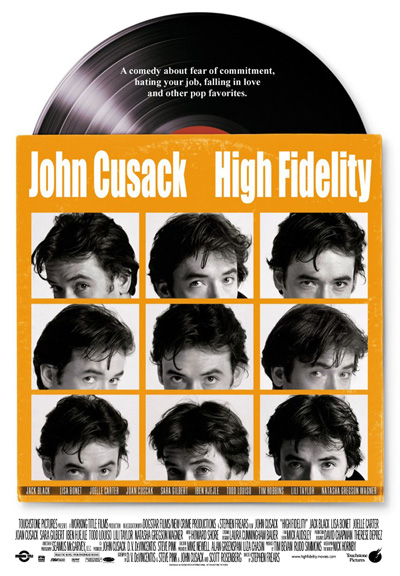“What came first, the music or the misery?” This intriguing first line seems to be a good representation of High Fidelity: a movie about heartbreak, rejection, faith and music.
High Fidelity is set in Chicago, where the main character Rob Gordon, played by the wonderful John Cusack, owns a record store on the corner of a street that attracts the bare minimum of window-shoppers. He is a walking encyclopedia of music and, together with his employees Dick and Barry, reeks of musical elitism that frequently scares away customers.

The plot begins as Rob and his girlfriend Laura break up, triggering flashbacks of Rob’s “Top 5 Most Memorable Split-ups.” As the movie progresses and Rob tries to win Laura back, he contacts his ex-girlfriends on the list and blatantly asks each of them about what he did to make them want to break up with him. During his journey through his past relationships and after the sudden passing of Laura’s father, Rob realizes that he never truly committed to Laura, hindering his self-development and in turn any development of his relationship with her.
Although Rob and Laura eventually get back together, High Fidelity doesn’t have a cheesy, happy ending like most romantic comedies. After realizing that he’s tired of all the fantasies brought on by other girls, Rob proposes to Laura, telling her that he doesn’t see himself ever getting tired of her. Despite Laura’s appreciation for Rob’s thought, she rejects his marriage proposal and the couple goes back to how they were before without any over-dramatic arguments.
As can be seen by its ending, High Fidelity is much more than a so-called “chick flick.” Although the plot is indeed not a typical one, it is not what makes the movie so unique. Throughout the course of the movie, Rob breaks the fourth wall and talks directly to the audience as he walks the audience through his top five lists of topics ranging from his dream jobs to bands or musicians who will have to be shot come the musical revolution. This method of narration not only catches the audience’s attention but also reveals the intimate thoughts of the main character that the viewers might not have discovered otherwise.
High Fidelity, by not conforming to the cookie-cutter structure of most movies, delivers a rich, realistic view on human relationships. Every character is developed to a degree appropriate to his or her role in the movie. A film critic said, “I had the feeling I could walk out of the theater and meet the same people on the street — and want to, which is an even higher compliment." Even minor characters such as Dick and Barry have distinct yet relatable personalities.
This movie has also become well-known for its carefully composed soundtrack, featuring songs by artists such as The Velvet Underground, Stereolab, The Kinks and Elvis Costello. The movie also features countless references to bands and musicians. Because their market only consists of customers who make a special effort to stop by, Rob, Dick and Barry spend their free time in the store discussing trivial details about music and quarreling over who is right. Some of the lists they create include “Top 5 Musical Crimes Perpetrated by Stevie Wonder in the '80s and '90s” (Sub-questions include: “Is it fair to criticize a formerly great artist for his latter-day sins?” and “Is it better to burn out than to fade away?”) and “Top 5 Songs About Death: A Laura's Dad Tribute List.” There are other, subtler references such as the posters hung up on the walls of Rob’s apartment and the band t-shirts that some characters wear. Although the average viewer can still enjoy and appreciate the movie without getting these references, a music fanatic or an audiophile gets the added pleasure of such minute details.
This movie is actually based on a book of the same name by Nick Hornby, also known as the author of the book and movie About A Boy. Unlike most film adaptations, High Fidelity beautifully represents the book. Excluding the change in location from North London to Chicago, there are few differences from the book as a lot of the lines in the movie are read directly from the book. Staying true to the book allows High Fidelity to be comedic, witty, insightful and poetic all at the same time, captivating the audience even over a decade after its release.
The movie comes to a finish as Rob tells the viewer how making a great mixtape for someone is as hard as remaining faithful in a relationship. As the credits begin to roll and Stevie Wonder’s “I Believe” plays in the background, the charmingly, romantically real movie High Fidelity will sneak into anyone’s top five list.

